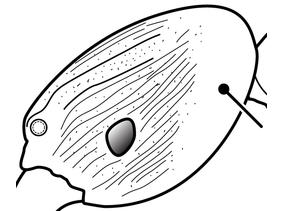TAXA (also search by using taxonomy search bar in header)
Pheidole flavens Roger, 1863
ระบบการเรียกชื่อสิ่งมีชีวิตแบบทวินาม
เนื้อหาโดยรวม
The following account is from Sarnat et al. (2015) and figure numbers refer to that publication.
Pheidole flavens belongs to the P. flavens-complex along with a putatively large number of other nominal taxa, including P. moerens Wheeler. However, the P. flavens group as conceived by Wilson (2003) is now known to be polyphyletic (Economo et al. 2015; Moreau 2008). Readers are referred to the P. flavens-complex for additional discussion of this species identification, taxonomy and systematics. The taxonomy of P. flavens and its close relatives remains in a state of confusion. It is beyond the scope of the present study to resolve this issue, but we contribute the following discussion as a step towards that goal.
Pheidole flavens was originally described by Roger from Cuba, but the type material is considered to be lost. Wilson (2003) designated a neotype from Cuba and synonymized a total of eight nominal taxa with P. flavens. Of these, P. greggi Naves (Florida) and perhaps P. flavens st. spei Santschi (Mexico) are most similar to the Cuban neotype. They, together with the types of P. moerens subsp. creola, are the only specimens examined thus far that have clearly reticulated rugulae posterior to the scrobes of major workers. Naves (1985: fig. 55) concept of P. flavens Roger, at least as evidenced by his figures and descriptions, more closely matches our concept P. navigans, a species that is spreading across the southeastern United States. The syntype major of Pheidole flavens var. vincentensis Forel differs substantially from the neotype in that the head is completely glossy between the rugulae, which are themselves entirely longitudinal and do not extend far beyond the maximum extent of the antennal scapes in repose. These characters make it at least superficially more similar to P. moerens and P. navigans. Pheidole flavens r. gracilior and P. navigans were both described by Forel from workers intercepted at a Hamburg quarantine facility, which is testament to the dispersive ability of this complex. The syntype major of the latter species and that of P. floridana subsp. aechmeae Wheeler, also described from Mexico, are quite similar. Pheidole exigua var. tuberculata Mayr has the strongly convex head and promesonotal dome of P. exigua Mayr, and also exhibits tuberculate angles on the mesonotal declivity. Type specimens of P. flavens var. haytiana Forel were not examined for this study.
The only material from outside Central America and the Caribbean that we were able to confirm as matching the Wilson’s neotype was from Florida. The Florida populations referred to here as P. flavens and P. navigans are almost certainly heterospecific. We suspect that Nearctic records of P. flavens outside of Florida such as those reported from Louisiana (Colby and Prowell 2006; Dash and Hooper-Bùi 2008) refer to either P. bilimeki or the species we are treating as P. navigans in the southeastern USA.






